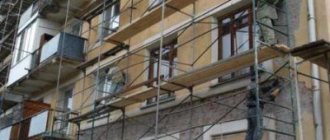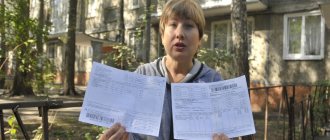Home/Apartment building/Common building needs
In receipt documents that are sent monthly to utility payers, in most situations you can find a column with general household needs (abbreviated as GDN). This concept is clearly stated in government decree No. 354 of May 6, 2011. In general, general house needs in 2021 include the difference between the benefits consumed by the house according to the common house meter, and the resources that were spent by each family individually (in accordance with the readings of apartment meters).
What are general house needs?
The abbreviation ODN, which appears on receipts and other utility documents in 2021, means nothing more than “general household needs.” It represents one of the categories of utility costs, which include the maintenance of common home areas where there are no individually installed metering devices.
Attention! If you have any questions, you can chat for free with a lawyer at the bottom of the screen or call Moscow; Saint Petersburg; Free call for all of Russia.
Attention
In practice, servicing aggregate residential areas may involve costs in various areas of resource benefits - electricity, heat, water supply (for more details, see Decree of the Government of the Russian Federation dated May 6, 2011 No. 354). The process of using these resources is called general household consumption, while the use of resources separately by each family is called individual consumption.
Normative base
Regulation of general house needs in 2021 is carried out within the framework of current legislation.
- Housing Code (in particular, Article 36). The documentation reflects the structure of general house needs, the procedures for settlement measures for their use, and other issues relating to the goods consumed by the entire house.
- Government Decree No. 354 of 05/06/2011. It also stipulates the norms and nuances of fees for services relating to general household consumption.
- Federal Law No. 258-FZ “On Amendments to Art. 154, 156 Housing Code of the Russian Federation.”
- General Law Federal Law No. 176, adopted in 2015. Its goal is to improve the conditions for payment of utility bills in order to increase payment discipline among the population.
- Federal Law No. 261 “On Energy Saving Standards”.
- Resolution No. 344 with all the necessary annexes regarding the provision of utility services to residents of apartment buildings.
Note: At
first, the Ministry of Construction tried to overcome the main difficulties that arose in paying for general house needs. The department allowed the charging of fees for one-way service in accordance with the meters. However, this step did not lead to fundamental changes. On July 29, 2017, the issue was finally resolved, and this happened at the federal level. Amendments were made to the housing code (Federal Law No. 258) on the rules for paying for needs that are common to the entire house. Housing and communal services are guided by them in 2018.
What is included in general house needs in 2021?
According to paragraph 1 of Art. 36 of the Housing Code of the Russian Federation, property units of the common building type include premises that are not apartments for residents and are used strictly for general use. These include the following areas:
- inter-apartment landings of stairs, corridors;
- elevator cabins, shafts;
- roof structures;
- technical floors;
- basement structures;
- attic buildings;
- land fund where the house is located;
- children's yard;
- flower beds.
That is, it turns out that the calculation actions for the ODN certainly include the fact of maintaining these territories. If we talk about the amount that residents regularly pay every month for general house needs in 2021, then we can include in it the following costly areas:
- energy resources consumed during the operation of intercoms;
- lighting of common areas - stairwells, basements, attics, vestibules;
- technological losses related to intra-house networks;
- electricity consumed by elevators and other units of electrical equipment used for general house needs (video cameras, pumps, heat control systems, etc.);
- cold water supply for maintaining lawns and flower beds, ensuring cleanliness in entrances and office premises;
- hot water supply to prepare residential buildings for the heating season and check their functioning.
Components of general household needs
What are the needs of the home and what can residents save on?
This is, first of all, electricity, which is required for the operation of intercoms, elevators, as well as lighting of stairs and basements. Also, the needs of an apartment building require specialized equipment.
- HVS. Maintenance of flower beds and lawns, maintaining cleanliness in entrances and office premises, cleaning sewers and other household needs.
- DHW. Activities related to the preparation of residential buildings for the heating season, that is, checking heating systems by releasing hot water, repairing radiators.
Tariffs for ODN in 2021
Standard parameters for general household needs for the population represent a discovery of information. This suggests that every resident of an apartment building can familiarize themselves with their values within the official resource of their management organization. At the same time, citizens living in their homes undertake to pay for utility bills in the manner prescribed by Russian legislation as amended (Federal Law No. 258 “On Amendments to Articles 154, 156 of the Housing Code of the Russian Federation” dated July 29 .2017 in a new edition).
The same legislative norm (Federal Law No. 258) implies that since 2017, meter readings, and not standard values, are used for settlement actions. According to this Federal Law, residents will pay for individual consumption, and in addition to this, for general household expenses. Their amount is directly proportional to the size of the apartment: the larger it is, the greater the amount withdrawn for general house expenses. In 2021, ODNs are not allocated as a separate line, however, no one has canceled the fee for them.
For your information
Standards for the consumption of resources for general household needs are usually subject to publication in the public domain. Therefore, each citizen retains the right to verify the correctness of the accrued payment, which ensures the transparency of settlement activities. In 2021, the Government approved the fact of increasing tariff estimates for the housing and communal services sector. But if we take into account the growth of the crisis, the increase in prices will occur moderately. There is an assumption that from July 1 of this year there will be an increase of 2.5-7.5%, depending on the specific region.
Changes
Starting in January, changes to the Housing Code of the Russian Federation came into force, establishing a system of payment for the use of common premises according to standards. These standards had to be adopted by the authorities in each region independently, taking into account the latest changes.
But the standards were not updated in all regions, and some housing companies, taking advantage of the innovations, did not reduce the payments of their residents, but increased them. Due to numerous complaints, the Ministry of Construction in February sent letter No. 4275 dated February 14, 2017 to all heads of constituent entities with explanations. The letter explained that if a building has common meters installed and the actual resource consumption is less than the established standards, residents pay according to the meters. If the consumption according to the meters is higher than indicated in the standards, residents pay only a fixed amount of the norm, and the management company pays for the excess. That is, apartment owners are not required to pay more than the norm, but have the right to reduced payments in case of saving resources.
However, this letter was of an advisory nature and was not accepted by all regions for implementation. Therefore, in the summer, the authorities adopted the law dated July 29, 2017 N 258-FZ “On amendments to Articles 154 and 156 of the Housing Code of the Russian Federation...”, which officially approved provisions on the priority of metering indicators in the formation of payments for single-use income.
Don't miss: Federal pension supplement: how much it will be, table
Who should pay for the provision of emergency services in 2021?
Attention
According to the norms and nuances of government decree No. 354, expenses for general house needs must be paid by apartment owners.
Payment is made in addition to individually consumed utilities and acts as a separate category of costs in the housing and communal services sector. Therefore, this does not have any impact on the order of payment arrangements, and does not depend on whether there are installed individual metering devices in a particular apartment. Owners of non-residential property pay the ODN payment according to an identical principle.
Payment of general house needs in 2021
In the process of settlement transactions for ODN within 2021, several planned changes occurred and were recorded (Federal Law No. 258).
- The increase in tariffs for utilities in general and for general household needs in particular has become a strictly regulated event.
- There are no separate lines provided within the invoice receipts for the needs of the house as a whole.
- The amount of costs spent on ODN is subject to detailed reflection in the total invoice.
- The average growth of utility services in recent years has been 3% (there are differences in regional areas).
- In the process of settlement transactions for ODN, an important role is played by the apartment area indicator.
- Citizens undertake to pay timely payments for utility services, including ODN.
- The reform will make it possible to achieve a more understandable and transparent scheme for settlement measures for utility bills.
In 2021, general house needs are included in the invoice by adding them to the total amount of general house costs. A separate line for this calculation is no longer provided. As part of the payment document, in the line implying the maintenance of common property, a separate registration of fees for each of the resources is made. That is, residents are assigned an obligation for a separate calculation of utilities and an additional payment for one-time tax.
The Ministry of Construction of Housing and Public Utilities published an approximate form of a single document, which contains the lines “consumption during the maintenance of common property in an apartment building.” To make the calculations more comfortable, on the lower right side of the document there is information about the total area of the house, as well as the total indicator for all common areas.
Calculation of ODN for electricity in an apartment building
In an apartment building, comfortable living depends not only on how warm and light the apartment itself is. Various technical rooms, common areas and elevators also require heating and lighting. The costs for this are classified as general house needs and fall on the shoulders of the owners of apartments in a residential building.
Before the onset of 2021, we saw the amounts of ODN in receipts for utility bills, but legislators proposed transferring these expenses into the category of payments for the maintenance of residential premises.
We tried to find out how the calculation of ODN for electrical energy has changed with the onset of the new year and whether it is possible to save on them.
As already mentioned, from January 1, 2021, the payment for one-person tax has been transferred to the category of expenses for the maintenance of common property, which means that the one-person line in the receipt should disappear. Now let's define what common property is. It is strictly defined by Article 36, Clause 1 of the Housing Code of the Russian Federation and includes all premises of an apartment building that are used for public use, excluding apartments:
- elevator shafts and cabins,
- corridors and staircases,
- technical floors, attics, roofs and basements,
- a plot of land under a house and adjacent infrastructure, for example a children's playground near the house.
Most apartment buildings are already equipped with common building meters for metering the consumption of utility resources (electricity, water and heat).
Many apartments have individual meters, according to which residents submit readings and utility bills are calculated. Essentially, common house needs are the difference between the readings of common house and individual appliances.
For those owners who do not have meters in their apartment, ODN is distributed based on the ratio of the apartment’s area to the total living space of the house.
What is ODN for electricity?
Lamps that illuminate the previously listed common areas in and around the house consume a certain amount of electricity. Also an elevator and other communications that are in common use. Of course, these are expenses, and far from small for a year. These ODN are distributed to all owners of residential areas of the house.
Previously, the utility organization that managed the house could set the ODN for electricity by subtracting the energy consumed from individual apartment meters and general house readings.
It was not possible to control how correctly each owner was invoiced under the ODN. And here some cunning, or, more simply put, fraud, of the management organization was acceptable.
From January 1, 2021, ODN for electricity was transferred to a housing service and strict standards were introduced according to which charges can be charged for the resources commonly consumed by the home.
They are derived by calculation and are close to real needs.
This measure helped not only to bring out of the shadows the income of utility organizations that dishonestly charge residents with inflated ODN, but also prompted them to more strict accounting, control and saving resources.
Standards for ODN for electricity in different regions:
Below is information that gives exact figures for electricity according to COI (composition of common property in an apartment building). Select your city, download the documents (take the standard figure), then calculate the one-time tax using the formula below.
- Moscow region - apartment buildings with elevators - 0.61; apartment buildings without elevators - 2.88
- Leningrad region (St. Petersburg) - download
- Nizhny Novgorod region - download
- Sverdlovsk region - download
- Omsk region - download
- Tomsk region - download
- Novosibirsk region - download
- Lipetsk region - download
- Yaroslavl region - download
- Republic of Tatarstan, Kazan - download
- Republic of Adygea - download
- Krasnodar region - download
How to calculate ODN in a high-rise building using a meter
The formula for calculating ODN is very simple. All the total areas of the house, living areas and the electricity tariff applied in a particular region are taken as a basis.
Ideally, the house should be equipped with a common house electricity meter (ODPU) and individual meters installed in each apartment. Then the calculation formula will look like:
Important!
Based on the formula, it is clear that each apartment owner pays for one apartment in proportion to the area of his apartment in the total area of the house.
Standard electricity consumption is a component of the calculation of ODN and is established by regional authorities. Accordingly, the costs incurred for electricity in excess of the norm will fall on the pocket of the organization managing the house.
If the volume of ODN is negative
A zero or negative value of one can result if the consumed volume according to the general house resource meter turns out to be equal to or less than the volume that is summarized according to the readings of individual metering devices. This can happen when several apartments in an apartment building do not have appliances installed and they pay according to the standard. However, their actual consumption is significantly less.
The supplier is obliged to recalculate the negative difference in one-time tax for a utility service, dividing it between residential apartments. In this case, a value is taken that is proportional to the people living in a particular apartment or the size of the total area. This procedure is stipulated in Art. 354 Government Decree.
Thus, if you find a negative value in a receipt for a utility service, for example, electricity, you can conclude that the fee has been recalculated taking into account the negative value of the ODN.
For example, the difference between a common household electricity device and the amount according to apartment meters was 130 kW/h. In total, 150 people are registered in the house. The difference will be distributed as follows: -130/150=-0.87 kW/h. In an apartment where 2 people are registered this month they consumed 100 kW/h. As a result of recalculation, the amount of energy consumed will be reduced by 2.61 kW/h.
What to do if there is no meter
In the absence of a common house electricity meter, the calculation is made taking into account the standards. The formula will be as follows:
Having calculated the share of electricity consumed by each homeowner, the management company adds it to the readings of individual meters, if installed, or to the standard and indicates it in the receipt for services.
Who should change the electricity meter on the landing in 2021
In most houses, electric meters that take into account the energy consumption of an individual apartment are installed in specially equipped panels on staircase landings. Any device does not last forever, so the meter may fail over time and will need to be replaced.
Every apartment owner who has a meter on the site needs to know that the replacement is carried out by the management organization.
Each housing organization must have a specialist on staff who has the right to inspect electrical equipment and install it.
If you discover a faulty meter or a broken seal, you must notify your management company. She will check, replace and seal the new device.
Attention!
However, this is not a general household metering device, but an individual one, and the cost of replacing it is borne by the owner of the residential premises. Therefore, in a privatized apartment, the consumer pays for the replacement, and in a municipal apartment, the municipality pays.
And in conclusion, I would like to note that the main part of the ODN for electricity - almost half - is the cost of lighting in the entrances and in the area near the house.
The following in descending order are the costs of various equipment, for example, pumps that supply hot water and heating to the house systems around the clock, as well as elevators.
And very insignificant, but also necessary, are the energy costs for connecting electrical equipment used for repair work.
: New rules for calculating General Household Needs
Still have questions? Find out how to solve exactly your problem - call the hotline right now or write to the consultant below.
+7 (Moscow)
+7 (Saint Petersburg)
+7 ext. 481 (Russia)
It's fast and free !
An example of calculating the amount of payment for general house needs in 2021
The amount of payment for general house needs in 2021 is calculated using two methods. The main criterion to which attention is paid is the presence/absence of a common house metering device on the territory of the apartment building. For this purpose, special formulas and norms are used that have been approved by the government; a general principle is applied, depending on a number of factors.
Tariffs for water and sewerage in the Troitsky and Novomoskovsky districts
| No. | Name of centralized water supply and sanitation systems in the territories of intra-city municipalities of Moscow | Name of consumers | Tariffs (RUB/m3) from 01/01/2018 to 07/01/2018 | |
| Cold water | Water disposal | |||
| 1 | Shcherbinka urban district | Population (including VAT) | 21,00 | 25,11 |
| Other consumers** | 17,80 | 21,62 | ||
| 2 | Settlements Moskovsky, Vnukovskoye, Voskresenskoye, Desenovskoye, Mosrentgen, Sosenskoye, Filimonkovskoye | Population (including VAT) | 36,64 | 36,67 |
| Other consumers** | 31,05 | 31,08 | ||
| 3 | Settlements Shchapovskoye, Klenovskoye | Population (including VAT) | 26,99 | 34,75 |
| Other consumers** | 22,87 | 29,45 | ||
| 4 | The settlements of Voronovskoye, Krasnopakhorskoye (with the exception of the village of Minzag), Mikhailovo-Yartsevskoye, Rogovskoye | Population (including VAT) | 22,07 | 36,03 |
| Other consumers** | 18,70 | 30,53 | ||
| 5 | Minzag subsistence village of Krasnopakhorskoe settlement | Population (including VAT) | 23,40 | 26,35 |
| Other consumers** | 19,83 | 22,33 | ||
| 6 | Settlement Ryazanovskoye | Population (including VAT) | 20,23 | 26,69 |
| Other consumers** | 17,14 | 22,62 | ||
| 7 | Troitsk urban district | Population (including VAT) | 23,14 | 27,65 |
| Other consumers** | 19,61 | 23,43 | ||
| 8 | Settlements Kyiv, Pervomaiskoye, Novofedorovskoye, Kokoshkino, Marushkinskoye | Population (including VAT) | 31,90 | 26,57 |
| Other consumers** | 27,03 | 22,52 | ||
* — Resolution of the Regional Energy Commission of the city of Moscow dated December 20, 2021 No. 432-v came into force on January 1, 2018.
** — tariffs do not include value added tax
The tariff for hot water was adopted by Resolution No. 545-gv “On the establishment of tariffs for hot water (hot water supply) supplied by the joint-stock company “Main Directorate of Housing and Communal Services” to consumers using closed hot water supply systems for 2021”
Payment if you have an OD meter
The procedure for carrying out paid activities for general house needs in the presence of a meter is as follows.
- Readings from this device are taken, which reflect the amount of resource consumed during the reporting period by the entire house - by residents separately and as a single unit.
- Next, the readings of individual devices installed in the apartments are summed up.
- To determine the specific amount of consumption for servicing common areas, individual indicators are subtracted from the total consumption.
- After obtaining information about all the indications, ODN are distributed to the owners by dividing by the total area of the building (we get the consumption per 1 sq. m).
- To calculate the one-room rent for a specific apartment, you need to multiply the value obtained in the previous paragraph by the area of each apartment.
- These indicators are then multiplied by the corresponding tariffs officially approved in the regions.
This procedure is reflected within the framework of federal law under number 258-FZ.
Consumption standards
To calculate the payment for ODN at the level of constituent entities of the Russian Federation, consumption standards must be approved. To determine the correct values, experts collect readings from hundreds of thousands of objects.
In particular, the volume of received resources according to the general counter and the volume of individually spent resources according to personal counters are taken into account.
The difference is considered to be the volume of communal resources that is necessary to maintain the common property of the apartment building. Comparing the results of all inspected houses allows us to determine the average indicator and approve it as a single standard.
Some issues related to the new procedure regarding ODN were clarified by the Ministry of Construction of the Russian Federation. So, when including ODN in the housing services of management companies (housing complexes, HOAs, etc.), they should be guided by Part 10 of Article 12 of Federal Law No. 176 of June 29, 2015.
In fact it looks like this:
| The actual amount of resources is presented for payment | Spent on maintaining common property |
| The resulting value is compared | With current regulations |
| If the actual volume exceeds the standard | Then the difference is paid at the expense of the management company |
| Residents of the apartment building | They pay for services within the approved standards |
Electricity
There is no uniform national standard for electricity consumption for apartment buildings. Determining the indicator depends on many factors, for example:
| Number of floors of the house | — |
| Availability/absence | individual heating station, elevator, pumping equipment, lighting of the entrance and adjacent areas |
| Home equipment | Common house metering device |
If we compare the approved standards in different regions, the values turn out to be very different. For 1 sq.m. The standard for electricity consumption according to ODN ranges on average from 0.6 kW/h to 7 kW/h.
To reduce the payment for one electricity tax you need to:
| Install a communal meter | The costs are paid off in a few months |
| Submit individual meter readings in a timely manner | Since the absence of real values leads to the calculation of payment according to consumption standards |
| Monitor the work | Managing organizations |
| Take care of replacing the old wiring with a new one | Which allows you to reduce energy losses to zero |
What is water used for?
ODN costs for cold water include:
- network cleaning;
- losses inside the apartment building;
- water consumption for general expenses for premises and adjacent areas.
One's expenses for hot water are spent on:
- technological work related to ensuring the operation of the heating system;
- water discharge during heating system repairs;
- intra-house losses.
Official standards for cold water consumption according to ODN, using the example of the Stavropol Territory, range from 0.029-0.067 cubic meters per 1 sq.m.
This takes into account factors such as:
- the presence of a drainage system in the apartment building;
- availability of centralized water supply;
- types of installed baths by volume, etc.
As in the case of electricity, the calculation of ODN for water supply is based on the difference in the readings of communal and individual meters.
Water disposal for general house needs cannot exceed the volume of water spent on single-use water supply systems.
Other
In addition to electricity and water supply, the ODN includes heating fees, since heat must be maintained not only in apartments, but also in common areas of the house.
But in this case, it is impossible to determine using meters how much heat is spent on each room separately. In addition, heating is always a utility service.
Regardless of the method of managing the MKD, heat is paid for collectively without dividing into personal and general household consumption. This norm is enshrined in clause 40 of the Rules for the provision of public services.
To calculate the payment for heating as part of the ODN, a thermal energy consumption standard is used, which is multiplied by the area of common premises in the house. The resulting value is divided among all residents.
Don't miss: All-Russian Subject Olympiad for Schoolchildren 2019-2020. Stages of implementation
Debt to pay for common household needs and consequences of non-payment
It is impossible not to pay for one-way service, as well as for basic utilities. This is evidenced by Art. 210, 249 of the Civil Code of the Russian Federation, as well as Art. 158 Housing Code of the Russian Federation. Since the costs of one-way service are currently not included in a separate column, but are included in the total amount of expenses, residents do not always check the correctness of their calculations. And if delays and non-payments are allowed, not only for general household purposes, but also for personally consumed resources.
The consequences of non-payment are obvious and include the following points:
- formation of fines and penalties;
- accumulation of debt on a large scale;
- the right of the management company to suspend the supply of certain goods on an individual basis (electricity, water supply);
- legal proceedings to collect debt;
- arrest of accounts;
- the likelihood of a ban on leaving the state.
Please note
: Non-payment has serious consequences. Taking into account the fact that general house needs in 2021 are relatively inexpensive for owners, it is easier to pay than to then expect the most unfavorable consequences.







